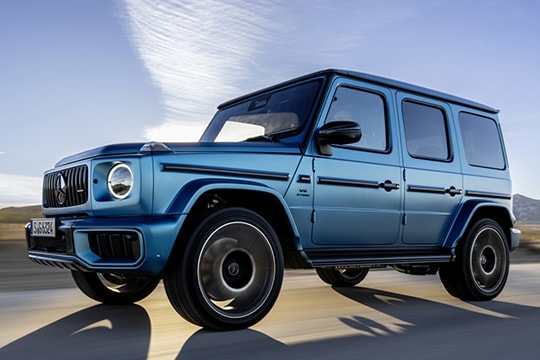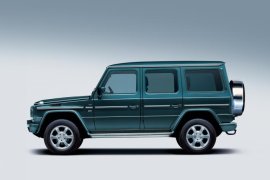MERCEDES BENZ G-Klasse Models/Series Timeline, Specifications & Photos
First production year: 1979
Engines: Mild hybrid diesel, Mild hybrid, Diesel, Gasoline
Body style: SUV (Sports Utility Vehicle)
Six years after the launch of the G-Class W463, Mercedes-Benz refreshed the renowned G-Class in 2024, continuing the production of this iconic off-road vehicle.
While other automakers tried to make their SUVs more aerodynamic, the G-Class remained true to its roots and featured the same squared-looking bodywork. Moreover, it still relied on the same body-on-frame construction that made it famous worldwide. Still, the automaker tried to smooth some corners of the vehicle, and a few details differentiated the 2024 model from its predecessor. Besides the exterior modifications, the German SUV had new interior amenities and, most importantly, new powertrains that featured electrification. All of them were fitted with a 48-volt electrical system and electric motors that helped the massive vehicle improve fuel efficiency.
At the front, the flat front fascia remained, but the radiator grille was adorned by four horizontal slats instead of three like its predecessor. Furthermore, the bumper was fitted with redesigned side scoops on the lower side, even though these couldn’t significantly improve the car’s aerodynamic coefficient. Furthermore, the exposed turn-signal lamps that doubled as parking lights mounted on top of the front fenders were already reckoned as signature design elements.
From its profile, the 2024 G-Class featured similar-looking grab handles for the doors and exposed hinges. Above them, the gutters were still there even though any other luxury SUVs on the market no longer used these elements. Other new details were noticed on the A-pillars, where the automaker installed new covers that helped lower the wind noise. To make the vehicle look more civilized, Mercedes-Benz provided it with standard 18-inch alloy wheels, but customers could opt for a 22-inch set. Its optional side steps were fixed and were on the options list. Finally, at the back, the automaker added the classic and exposed spare wheel mounted on the rear door. Here, buyers could either have that supported by a closed cover or by a rough-looking cradle with steel bars.
Inside, Mercedes-Benz tried to create a luxurious ambiance for its customers. Fronting the driver was a digital display, continued by a touchscreen placed atop the center stack. Between the round, turbine-like vents on the center stack, the automaker installed the classic buttons that locked the three differentials of the vehicle. Behind the steering wheel, drivers could find the stalk for the automatic transmission on the right, while on the left was the same do-it-all stalk for the turn signals, wipers, and headlights. As expected, the three-spoke steering wheel boasted several buttons that controlled the MBUX infotainment system and the adaptive cruise control or helped them see various information provided by the car’s onboard computer. In the back, the 2024 G-Class was available with additional screens for the rear passengers.
But the most significant difference was found under its hood. Mercedes-Benz provided the 2024 G-Class with either an inline-six turbodiesel or an inline-six turbocharged gasoline unit. Both were paired with a nine-speed automatic transmission and helped by a belt-driven starter generator. However, despite all these, the car remained true to its roots. It could pass through 70 cm (27.6 inches) of water and featured a solid axle in the rear, while at the front, the automaker installed an independent suspension.
The 2018 Mercedes-Benz G-Class was not a new generation for the famous off-road vehicle. It was a completely new book that changed the whole concept of the vehicle.
For almost four decades, the Mercedes-Benz G-Class (or G-Wagon) was the same rugged vehicle, with a ladder-chassis and solid axles front and rear. Over the years, some of its characteristics were improved. The basic, cloth, the interior was changed to exclusive leather. The 4-speed manual was upgraded up to a 7-speed automatic with dual-clutch and the four-banger with a carburetor was replaced to state-of-the-art V8 with direct injection and twin-turbo. But the ladder-chassis was the same. The solid axles were still in place and the three lockable differentials were installed as well.
In January 2018 the new G-Class was shown at the North-American International Auto Show in Detroit. The new G-Class was 121 mm (4.8") wider, 53 mm (2") longer and 39 mm (1.5") taller. The increase in the ground clearance was a mere 6 mm (0.23"). But there was a new ladder-type frame and a double-wishbone suspension on the front. The rear axle was kept, but with a different type of connection to the chassis. The three lockable differentials were kept and the low-gear transfer box as well.
And so, the 2018 G-Class succeeded to bring more comfort and still the same off-road abilities as the older version. At the time of launch, there were three engines available: two gasoline units and a brand new inline-six turbodiesel. These were mated to a 9-speed Speedhift MCT transmission.
Mercedes-Benz went back to the roots of the G-Class in 2016 when it introduced the Professional version of its well-known SUV, which was made for those who needed a trustworthy, rugged, off-road vehicle.
When the German automaker created the original 1979 G-Class, it built it as a utility or army vehicle. Along the road, the vehicle became a toy for those with deep pockets and became a very expensive car. Some of its versions were even more expensive than the brand’s flagship, the S-Class. But the automaker didn’t forget where it all began when it developed the 2016 G-Class Professional. Even though it was no longer based on the W461 chassis, which was used for military and utilitarian range on the W463 one used by luxurious or go-fast G 65 AMG, it was built to overcome any obstacle mother nature would throw at it. While it was still expensive, its high price was for the technology that made the car reliable enough to circumnavigate the Globe ten times in a row without tearing a sweat, just with regular maintenance.
It had no chromed details nor shiny trims on its front. Just a black three-pointed star badge and the same-color three-slat grille. Its round headlights were underlined by LED daytime running lights due to regulations, not because it needed them, and customers could opt for metallic grilles to protect them. The front plastic bumper could be replaced with a steel one specifically designed to host a winch behind it.
From its profile, the G-Class Professional started to reveal its true intentions. It featured truck-like tall door mirrors without any turn signals. Even the metallic side steps were optional and had their aluminum frame exposed to give customers more trust in them. The black moldings around the wheel arches were from unpainted plastic, so they could be cheap and easy to replace if torn apart by some boulders or other obstacles. Its five-spoke, 16-inch alloy wheels were wrapped in all-terrain tires, and customers could easily replace them with MT ones. Finally, at the back, the car featured a unique bumper that sported a red fog lamp and a clear reversing one. The automaker offered a wide variety of options for the car’s exterior, such as a roof rack with a ladder placed next to the side-hinged rear door.
The interior lacked most of the features commonly used in a 2016 vehicle. There were cranked windows for all four doors. Furthermore, the SUV came fitted with manually adjustable seats and cloth upholstery. Furthermore, there was no touchscreen atop the center stack for an infotainment system; there was just an oval badge with the word “Professional” on it. At least the automaker considered adding an air-conditioning system with big round turning knobs. On the center console, Mercedes-Benz installed the lever for the automatic transmission, while fronting the driver was a binocular-styled instrument cluster sporting the same dials as the GLE-Class.
Under the hood, the 2016 W463 G-Class Professional featured a 3.0-liter turbodiesel engine carried over from the carmaker’s parts bin. Mercedes-Benz paired it with a seven-speed automatic transmission. Like the rest of the G-Class range, the SUV came fitted with a two-speed transfer box and three manually locking differentials. Unlike the rest of the range, the G-Class Professional featured stiffer springs and dampers, allowing it to carry heavier items on board or on its roof rack.
MERCEDES BENZ G-Class Professional (W463) 350 d 7AT (245 HP)
In 2015, Mercedes-Benz introduced a lifted version of the G-Class, and added an impressive ground clearance to a vehicle that was already difficult to challenge on rough terrain.
With its bodywork carved in wood and the stance of a building, the G-Class 4x4 squared was a massive SUV that could easily run over any curbs in any city without noticing it. Furthermore, its loud biturbo V8 engine could prevent its driver from hearing if they were called from the outside. And then, it was the attitude of the go-anywhere and do-anything kind of vehicle someone could trust to take them from Pole to Pole, from Canada to the infamous Tierra del Fuego in South America. Even though this SUV was made to do all that, it was mostly used as a super-expensive toy. Only this time, it was more challenging to handle.
The vehicle’s over seven-foot height could impress anyone without a CDL in their pocket. Its grille, the three-pointed star badge, and the Xenon headlights were at a height where most other vehicles had their roofs. Moreover, the turn signals were mounted on the upper side of the fenders. The unpainted, black plastic moldings that adorned the wheel arches emphasized the car’s width, covering the 325/55 tires wrapped around 22-inch light alloy wheels.
From its profile, the five-door station wagon revealed the image of a vehicle able to go through three feet (one meter) of water safely. The side steps covered the side-mounted twin exhausts on each side, like on a G-Class AMG, even though the SUV didn’t sport those famous three letters. However, Mercedes-Benz tried to use the same parts as those from the regular G-Class, so it installed the same body-colored door mirrors that featured V-shaped turn signals as on the rest of the range. Out back, unlike any other G-Class, the 4x4 Squared version didn’t have the spare wheel attached to the rear side-hinged door. It was too heavy.
The car’s interior was luxurious, featuring high-bolstered front seats with a mix of Alcantara and leather upholstery. Between them, on the center console, the automaker placed the controller for the infotainment system and the lever for the automatic transmission. Atop the center stack, Mercedes-Benz installed a seven-inch screen that, besides the info about the music, showed the navigation and other useful data used while driving on and off the road. In the back, the bench seat could accommodate three people, while behind them, there was a net that separated the cabin from the luggage compartment. Thanks to that partition, the SUV could be registered as an LCV in many European countries.
Under the hood, Mercedes-Benz installed a 5.5-liter biturbo engine paired with a seven-speed automatic gearbox. A two-speed transfer box sent the power in all corners via a locking center differential. Unlike the rest of the G-Class range, the 4x4 Squared version featured portal axles that increased the vehicle’s ground clearance to 450 mm (17.7 inches), improving attack, departure, and breakover angles. As an option, the car could be fitted with 37 x 12,5 MT tires mounted on 18-inch Beadlock wheels.
MERCEDES BENZ G-Class 4x4 squared (W463) 500 7AT 4x4 (422 HP)
Four years after the previous facelift, the G-Class was ready to receive another update, this time to prepare it for stiffer European emission regulations, but also with added safety features.
Unlike most other cars on the road, the G-Class was designed in the ‘70s and constantly upgraded. In the ‘90s, the automaker switched from the previous W460 to the W463 designation, but the SUV’s underpinnings remained largely unchanged. The massive vehicle relied on a ladder-frame chassis with solid axles on both ends. These were perfectly fine while offroad-ing but were not the best for on-road behavior. Despite all that, customers loved the boxy-looking vehicle that required more muscle to drive than any other Mercedes-Benz car. After a refresh in 2008 that introduced more amenities to the interior, the automaker had to work harder to make the vehicle suitable for the Euro 6 emission standards due to enter in 2015. These also required manufacturers to improve their safety systems and add specific items to the vehicles, such as daytime running lights. As a result, the 2012 G-Class came with significant updates, making its customers and the carmaker’s bean counters happy.
The flat front fascia went through some changes. Its grille sported three chromed horizontal slats for the regular version. At the same time, the AMG package and the AMG versions got twin slats. All versions featured Xenon headlights in new clusters, underlined by LED bars for the daytime running lights. Lower, on the bumper, the automaker included a plastic bumper with oval-shaped fog lamps that doubled as cornering lights.
From its profile, the long-wheelbase version of the 2012 G-Class featured new door mirror caps with turn signals that looked like arrows pointing outward. These replaced the previously used line-type blinkers from the 2008 model year. On the front bumpers, the automaker installed fake vents in the rear area, above the waistline. As a tribute to the car’s original design, the automaker kept the long horizontal trim that ran from the front to the back of the vehicle. The door handles, which were grab-type, were visually integrated into it. A set of metallic side steps helped passengers get in and out of the vehicle, especially those seated in the back since the doors were still narrow compared to the sheer size of the G-Class.
Inside, the automaker refreshed the interior. It added a new steering wheel and an instrument panel featuring a binocular system for the speedometer and tachometer. Between these dials, the automaker placed a squared TFT color display that showed additional data from the car’s infotainment system or the onboard computer. Another significant upgrade was the COMAND infotainment system, which featured a free-floating seven-inch screen atop the center stack. Mercedes-Benz installed a controller for it, integrated into the center armrest that separated the front seats. In the back, the split-folding (60/40) bench seat could accommodate three passengers, but with not that much legroom due to the redesigned front seats that integrated side airbags.
Under the hood, Mercedes-Benz offered the G-Class with a choice of two engines: a three-liter turbodiesel or a 5.5-liter gasoline. The former was a V6 and targeted mostly European customers, while the latter aimed at the North American market. Both versions sent their power in all corners via a 7G-TRONIC PLUS automatic transmission fitted as standard.
Mercedes-Benz continued to upgrade the G-Class W463 lineup in 2008, and in addition to the updated exterior, customers received a vehicle with a better interior that made them feel more comfortable.
It would be unfair to say that the G-Class has been virtually unchanged since its introduction in 1979. But still, it kept its original shape, chassis, and rigid axles. On the other hand, the already iconic SUV from Mercedes-Benz had a new transmission with a better gearbox and transfer box. In addition, all of its engines expressed their power in triple digits. Besides these, the automaker also improved the vehicle’s interior to fit into the luxury segment. Unfortunately, Mercedes-Benz was reluctant to start selling the G-Class in the U.S., where the SUV was also known as the G-Wagon. But it fixed that so deep-pocket customers could get one, legally, and drive them in Beverly Hills.
People loved the bodywork, so the German automaker just slightly upgraded it. As a result, the front side of the vehicle featured new Xenon headlights, depending on the market. Customers could also get the full-size SUV with either three wide horizontal slats or multiple, thinner ones. The lower bumper sported a central vent in the middle, which could be cut to install a winch, flanked by oval fog lamps that doubled as cornering lights.
From its profile, the body-colored flared wheel arches were visually connected by the side sills. Depending on the version, the 2008 G-Class was available with side exhausts, which added more character to the car. Still, the door hinges were exposed, but that was a design detail that customers appreciated. The 2008 W463 five-door was fitted with standard 18-inch light-alloy wheels. At the back, the automaker installed new taillights equipped with LED technology. Even though they kept their squared shape, they sported an inner oval design with outer-mounted clear lenses for the reversing lights. Above the side-hinged door that sported the spare wheel, the automaker installed a rear-view camera, which was standard or optional, depending on the engine version.
Inside, customers found a completely new dashboard. The instrument cluster was filled with four analog dials with silver encirclements, with a black and white LCD in the middle. It looked like it was carried over from the facelifted C-Class W203 model that was about to be replaced by the C-Class W204. On the center console, Mercedes-Benz installed a new COMAND infotainment system with voice commands. In addition, it was Bluetooth-compatible, allowing connection with mobile phones. The G-320 CDI version was fitted with a leather-wrapped steering wheel, while the G500 and the G55 AMG sported leather and wood trims. In the back, the split-folding bench seat was wide enough to accommodate three adults, with enough legroom even for tall people.
Under the hood, the 2008 G-Class was available with a choice of two engines: a 3.0-liter turbodiesel and a 5.0-liter V8. Apart from them, the automaker also offered a G55 AMG version, which was a different kind of animal in terms of performance. Regardless of the engine choice, customers were spoiled with a seven-speed automatic gearbox that sent the power in all corners via a two-speed transfer box. Like all the W463 versions, the 2008 G-Class came with three manually locking differentials.
In 2006, Mercedes-Benz added another upgrade to its well-known G-Class W463, giving the vehicle a mild exterior update that made it more appealing to customers.
In 2005, Mercedes-Benz’s board decided to continue production of the G-Class. The milestone decision kept the big and old SUV on the assembly lines, and the vehicle’s fans were happy. The car was already an iconic model, and its steep price transformed it into a luxury item for many people around the world. But there were some essential changes to be made to the G-Class to keep it on the sales floors. One of the reasons why the automaker had to take that decision in 2005 was due to the Euro 4 emission standards that were due to be enforced starting in January 2006. As a result, the automaker had to axe the 400 CDI and the 270 CDI versions, as well as several gasoline engines. To make these changes visible, the automaker also updated the G-Class exterior, starting in mid-2006 for the 2007 model year.
At the front, customers finally got what they were asking for: Xenon lights. These were unavailable before the fall of 2007, but these significantly improved nighttime driving compared to the older Halogen-based headlamps. Furthermore, the automaker used the available oval-shaped fog lamps as cornering lights, which also added a little bit of flair to the massive G-Class.
From its profile, the 2007 G-Class W463 featured body-colored trims on the wheel arches and side sills. Its turn signal lamps integrated into the door mirror caps were carried over from Mercedes-Benz’s parts bin. At the same time, the long black rubber trim that crossed the vehicle from front to back protected the black door handles, neatly integrating them. The side-hinged rear door supported the spare wheel like on all the previous G-Class models, even though it had already become inconvenient, especially for those driving the car within city limits.
Inside, the automaker still used the same old C-Class W203-inspired instrument panel with its half-circle center-mounted speedometer flanked by the tachometer on the left and by the fuel level gauge on the right. It even kept the amber-lit LCD inside the speedometer. In addition, Mercedes-Benz used other parts from the W203 on the G-Class, such as the climate control buttons from the center stack. The infotainment system and the steering wheel were carried over from the E-Class W211. But the automaker made the seats specifically for the G-Class. These were available with a two-stage heating function for the first row. Those seated in the back had to rely on the vehicle’s regular heater. At least they had plenty of legroom.
Mercedes-Benz offered the 2007 G-Class with a choice of two engines: a three-liter V6 and a 5.0-liter V8. The former was a turbodiesel that replaced the V8 and the inline-five units of 4.0-liter and 2.7-liter, respectively, while the latter was a gasoline powerplant. Both were paired as standard with a seven-speed automatic (7G-Tronic) gearbox, which was tried and tested since 2003 on the E-Class and the brand’s flagship, the S-Class.
Ten years after the introduction of the W463 series, the German automaker released a proper facelift for it, which, besides the drivetrain and interior improvements, also refreshed the engine lineup.
One of the things that Mercedes-Benz was reluctant to change dramatically was the SUV’s exterior. While other automakers were keen on modifying or completely replacing some body panels, the German car manufacturer was not. This is not because it couldn’t do that, but because its customers said that they were satisfied with the look of the G-Class. But still, there were some upgrades to the bodywork. The interior was also improved significantly and boasted more amenities. Last but not least, the engine lineup was upgraded, especially since there were new emission standards that the car had to comply with.
At the front, the car featured a plastic three-slat grille where the three-pointed-star chromed badge took center stage. Like the non-facelifted version, it was flanked by the round headlights integrated into individual clusters. The blinkers and parking lights mounted on top of the front fenders were already trademarks of the G-Class, so Mercedes-Benz left them there, but with a slightly different design, with amber bulbs behind the clear lenses. Another upgrade was for the bumper, which was made from ABS materials and could be upgraded with fog lamps.
From its profile, the SUV boasted its new body-colored door mirrors with integrated turn signals. This was a necessary upgrade since the car was already seen as a luxury vehicle. In addition, the flared wheel arches were also body-colored. For the five-door version, the available side steps eased ingress and egress to the vehicle, especially for the rear passengers. Out back, the side-hinged door supported the full-size spare wheel, even though it could fit inside the large trunk of the car.
While the exterior was upgraded just in a few parts, the interior went through a major revamp. The instrument cluster featured a similar design to the one offered by the newly introduced C-Class W203. There was a large speedometer placed in the middle, flanked by the tachometer on the left and the fuel gauge on the right. Surprisingly, the coolant temperature wasn’t shown on the gauges. To see that, the driver had to access the car’s onboard computer via the buttons on the steering wheel that resembled the one installed in the E-Class. On the center stack, the automaker integrated the new COMAND infotainment system that could’ve been accessed via buttons or by voice commands. Furthermore, the automaker offered a navigation system and even phone-based assistance (TELEAID) since the car could be fitted with a GSM phone. The optional wood trims on the dashboard, steering wheel, and center console emphasized the leather upholstery and the high level of luxury. The front seats were available with heating, while the rear ones were not.
Under the hood, Mercedes-Bens installed Euro 3 gasoline or turbodiesel engines. The automaker also introduced the 5G-Tronic automatic gearbox on the 2000 G-Class. Furthermore, it ditched the lower-powered powerplants and introduced new, potent ones, such as the 4.0-liter V8 turbodiesel and the 5.0-liter V8 naturally aspirated gasoline unit. Power went into all corners via a high and low-gear transfer box. All versions came with the already famous three locking differentials.
In 1989, Mercedes-Benz introduced the W463 as a successor for the W460 G-Class that it launched in 1979, and unlike its predecessor, the new model came with better interiors and on-road behavior.
A hard-core off-road vehicle had to have different attributes than a road-oriented car, and Mercedes-Benz tried to create a perfect blend with the 1989 G-Class, or G-Wagon as it was also known in the U.S. After researching customers behaviors and needs, the German automaker understood that the car needed a new interior. In addition, it enhanced the drivetrain and slightly polished the bodywork, which remained as boxy as ever. Last but not least, it finally offered more powerful engines for a car that was tested from the Sahara Desert to the North Pole. It is worth mentioning that Mercedes-Benz created two different ranges of products. The W463 was destined for the civilian market, with all the features and amenities of a three-pointed-star badged vehicle. At the same time, the W461 was kept in production for the military, NGOs, and other law enforcement agencies around the world.
The W463 long wheelbase was available in a five-door configuration. Its front fascia didn’t differ too much from its predecessor. But still, it sported a body-colored grille flanked by big and round headlights. Even though it could put the turn signals lower, the automaker left them on top of the front fenders, like on the original model. Furthermore, customers could get the vehicle with a set of fog lamps integrated into the bumper.
From its profile, the car kept its shed-like shape, sporting angular cuts for the wheel arches and a rubber line that crossed the vehicle from front to back, interrupted only by the door handles. Like its predecessor, the 1989 G-Wagon featured exposed door hinges, which surprisingly were appreciated by customers. Out back, the side-hinged tailgate sported the spare wheel on it, even though there was enough room for it in the large trunk.
Inside, Mercedes-Benz introduced many options for the vehicle. Besides the air-conditioning unit, which had been provided since the early ‘80s, the W460 was available with wood trims on the dashboard and leather upholstery. The instrument cluster resembled the one from the E-Class (W124), not the one from a truck. Furthermore, the automaker installed a wider center stack where switches for the three locking differentials were placed. Between the front occupants, Mercedes-Benz placed the gear selector (or the gear stick, depending on the options) and the transfer case selector. Thanks to the long wheelbase, there was enough room for three adult-sized passengers in the back on the folding bench seat.
But the real transformation happened under the hood. Gone were the carbureted, underpowered engines. In addition, the all-wheel-drive system fitted with three locking differentials was unique on the market. As a result, the off-road performance was astonishing. Furthermore, thanks to the re-calibrated coil-spring suspension, the G-Class became more comfortable when driven on paved roads, and that bumped the sales.
There are not many cars in the world that achieve icon status, such as the Mercedes-Benz G-Class that the German automaker introduced in 1979 and built in several shapes and sizes.
In the early ‘70s, the Shah of Iran, Mohammad Reza Pahlavi, needed a sturdy vehicle for its army. Since he was an important stakeholder in Mercedes-Benz, he persuaded the carmaker’s board to develop one. At the same time, in the UK, Land Rover was riding the high tides with its Series III and the Range Rover lineups. As a result, work started on the Gelandewagen (all-terrain vehicle in German). To build it, Mercedes-Benz partnered with the Austrian manufacturer Steyr, and the result was the 1979 G-Class. The SUV was initially available in with a short or a long wheelbase, five types of bodywork, and four engines. One of the first large orders came from the Shah of Iran, but the Islamic Revolution happened before the cars were delivered. That didn’t stop the German automaker from producing the vehicle and selling it everywhere. The car got the internal coding of W460.
Mercedes-Benz’s engineers used wood instead of clay to shape the vehicle since that material better suited their intentions. They wanted the vehicle to look rugged, with flat surfaces. As a result, even the front fascia was flat. A black grille dominated it, and on its upper sides, the automaker placed the headlights. To protect the turn signals, these were mounted on the upper side of the front fenders, flanking the hood.
The five-door version was the one that aimed at those looking for a recreational vehicle. Since the G-Class could tackle any kind of terrain, it was ideal for camping and going into the woods without fearing getting stuck that easily. Mercedes-Benz made the vehicle with flat side panels so they could be better protected. The only elements that were wider than the bodywork were the door handles and mirrors. Its exposed front doors’ hinges remained a trademark of the vehicle. At the back, the SUV featured a side-hinged door that also supported the spare wheel.
Inside, Mercedes-Benz created a cabin that was far from the rest of the luxurious vehicles it made. The fabric upholstery and the squared-looking dashboard were closer to an LCV than to an expensive, luxurious SUV. But still, customers loved it thanks to the ease of use. Fronting the driver was a small instrument cluster that featured three dials. The one on the left was the speedometer, while the one on the right was filled with the gauges for the fuel level and coolant temperature. Between them, on the upper side, the automaker installed the rev counter. Depending on the options, the center stack housed the stereo, an analog clock, the heater controller, and an ashtray. Between the front seats, Mercedes-Benz installed the gear stick, the transfer case lever, and two plungers to lock the front and rear differentials. In the back, the bench seat was wide enough to host three adults, while behind them was the trunk.
But the most significant part of the vehicle was its chassis, which made the G-Class so famous around the Globe. The transmission featured a transfer case with a 50:50 torque distribution between the front and rear axles. While that was an advantage in off-road situations, it was less suitable for on-road applications since the SUV didn’t have a center differential. That was added later.
MERCEDES BENZ G-Klasse (W460/W461) 200 GE (G-Kat) 4MT AWD (118 HP)
MERCEDES BENZ G-Klasse (W460/W461) 200 GE 4MT AWD (122 HP)
MERCEDES BENZ G-Klasse (W460/W461) 230 G 4MT AWD (109 HP)
MERCEDES BENZ G-Klasse (W460/W461) 230 GE (G-Kat) 4MT AWD (122 HP)









